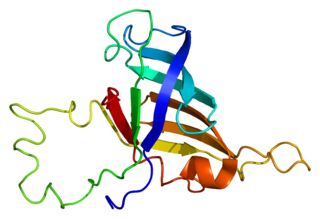RNA polymerase II elongation factor ELL is an enzyme that in humans is encoded by the ELL gene. [5] [6] [7]
RNA polymerase II elongation factor ELL is an enzyme that in humans is encoded by the ELL gene. [5] [6] [7]

DNA-directed RNA polymerase II subunit RPB1, also known as RPB1, is an enzyme that in humans is encoded by the POLR2A gene.

DNA-directed RNA polymerase II subunit RPB3 is an enzyme that in humans is encoded by the POLR2C gene.

DNA-directed RNA polymerases I, II, and III subunit RPABC1 is a protein that in humans is encoded by the POLR2E gene.

DNA-directed RNA polymerase II subunit RPB2 is an enzyme that in humans is encoded by the POLR2B gene.

DNA-directed RNA polymerase II subunit RPB7 is an enzyme that in humans is encoded by the POLR2G gene.

DNA-directed RNA polymerases I, II, and III subunit RPABC3 is a protein that in humans is encoded by the POLR2H gene.

DNA-directed RNA polymerases I, II, and III subunit RPABC5 is a protein that in humans is encoded by the POLR2L gene.

Elongin C is a protein that in humans is encoded by the ELOC gene.

Elongin B is a protein that in humans is encoded by the ELOB gene.

General transcription factor IIH subunit 4 is a protein that in humans is encoded by the GTF2H4 gene.

Transcription elongation factor SPT4 is a protein that in humans is encoded by the SUPT4H1 gene.

Elongin A is a protein that in humans is encoded by the ELOA gene.

General transcription factor IIF subunit 1 is a protein that in humans is encoded by the GTF2F1 gene.

General transcription factor IIF subunit 2 is a protein that in humans is encoded by the GTF2F2 gene.

Mediator of RNA polymerase II transcription subunit 26 is an enzyme that in humans is encoded by the MED26 gene. It forms part of the Mediator complex.

ELL-associated factor 2 is a protein that in humans is encoded by the EAF2 gene. It is part of the EAF family of proteins.

ELL-associated factor 1 is a protein that, in humans, is encoded by the EAF1 gene. It is part of the EAF family of proteins.
In molecular biology, the EAF family of proteins act as transcriptional transactivators of ELL and ELL2 RNA Polymerase II transcriptional elongation factors. EAF proteins form a stable heterodimer complex with ELL proteins to facilitate the binding of RNA polymerase II to activate transcription elongation. ELL and EAF1 are components of Cajal bodies, which have a role in leukemogenesis. EAF1 also has the capacity to interact with ELL1 and ELL2. The N terminus of approx 120 of EAF1 has a region of high serine, aspartic acid, and glutamic acid residues.

Ali Shilatifard is an American biochemist/molecular biologist, the Robert Francis Furchgott Professor and Chairman of the department of biochemistry and molecular genetics, and the director of the Simpson Query Institute for Epigenetics at the Northwestern University Feinberg School of Medicine. He has served as a senior editor for the journal Science, and currently serves as the Editor for Science's open access journal Science Advances. Research in Shilatifard's lab focuses on the cause of childhood leukemia through chromosomal translocations, the role of ELL in this process, and the discovery of the Super Elongation Complex as being a central complex linking MLL translocations into a diverse number of genes to leukemic pathogenesis.

Elongation factor RNA polymerase II-like 3 is a protein that in humans is encoded by the ELL3 gene.